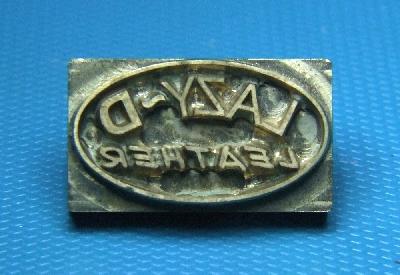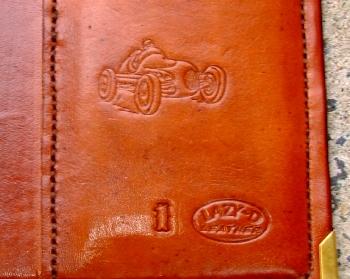-
Posts
5,923 -
Joined
Content Type
Profiles
Forums
Events
Blogs
Gallery
Everything posted by fredk
-
I find that thin leathers, up to about 2.3mm, will shrink upon drying after being dyed and lacquered. With a general bag or belt the shrinkage is hardly noticeable but on something which is made to fit tightly round something this shrinkage can hurt or aid ~ eg, I have fit quite tightly some leather over a knife sheath then dyed it, it then shrank to make it so tight it was impossible to remove, on t'other hand I dyed two halves of a case, let them dry and then they would not fit around the object they were for, now for that case I form and sew up in situ and then dye, as the leather dries it tightens up, I can then cut the case open I always dampen my leather before dyeing. NFO goes on at the end
-

Is this wrinkling normal for a dual layer belt?
fredk replied to patrick2099's topic in Leatherwork Conversation
That is pretty much normal A true belt making expert can make a belt in which this hardly happens but those experts are hard to find PS. I'm assuming that is the inside. If its the outside then, no it shouldn't look like that -
Is that line of stitching by your finger-tip the stitching for the lining? If it is, I would cut that stitching with a scalpel, just enough to slip a leather repair patch in past, then use fine thread to re-sew the lining. I would make the repair patch from about 3 holes to the right thru to about 6 holes to the left of the ripped double
-
I just got an email from Tandy telling me that everything in the Tandy Library is Free Who would have thought?
-
Even debit/credit card is old skool now. In some areas of Belfast you can only pay for on-street parking or in car parks using a 'smart phone' and I've heard that at least two 'posh' restaurants are the same, pay with your 'smart phone' My son takes cash or bank transfer for payment. He's had customers arrive with no cash and they have done a bank transfer right there using their ipad thingies
-

Does mail order leather usually look like this
fredk replied to Fcapela's topic in Leatherwork Conversation
My orders from Le Prevo always come rolled up. It would be impractical to send it flat. I keep it rolled up and only unroll it just before I need it. Usually it just flattens out itself, sometimes it needs a bit of dampening to encourage it -

Cowboy Single Action loading strips
fredk replied to noobleather's topic in Gun Holsters, Rifle Slings and Knife Sheathes
A very functional item made extremely nice looking. It'll be a pleasure to the owners to have these -

Please help with saddle ID
fredk replied to RebeccaFe's topic in Saddle Identification, Restoration & Repair
I can't see the coin too clearly but it looks pre-Hitler regime, possibly the Weimar Republic PS. Yes, insure it. Go to a saddlery or tack shop. See what a similar looking modern saddle sells for then insure this for 2 to 4 times that amount. You may be able to add it to your house contents insurance as a named single item. There will be an extra premium on your house contents insurance for it. -

Please help with saddle ID
fredk replied to RebeccaFe's topic in Saddle Identification, Restoration & Repair
Wipe it down gently with saddle soap. Mix some bees' wax with pure neatsfoot oil into a cream, like margarine, and apply that. Work an area at a time, overlapping the areas. Rubbing the cream into the leather, let it sit for a couple of hours then lightly buff it off. A couple of treatments like this and it should come up a treat -
Out of my price range. I get brass stamps cut by an ebay seller. 5cm x 5cm is £24. I provide jpeg artwork and get a stamp back in about 10 to 12 days The 20mm across stamp I posted a picture of above cost me £14.99
-
1. Wet your leather. Wipe it over with a wet sponge. Damp but not soaking wet 2. dilute the dye and apply several thinned coats to reach colour density
-
Just finished downloading another load of files. 110 done so far. I'll be printing out a portion of the pages, Thats gonna cost me!
-
Have either of youse thought of using a one-handed clamp? They don't tighten up as much as a regular C cramp but tight enough for the embossing https://www.ebay.co.uk/itm/Quick-Grip-Ratchet-Vice-Bar-Clamps-4-Inch-100mm-Rapid-Clamp-Spreader-Freepost/231842810316?hash=item35fae889cc:g:L0kAAOSw0PBdAQkz
-
Well, thank you Mr Tandy. I do like a lot of their patterns and tip sheets
-
yeah but, no but, yeah but. . . . . look how many more you can get for nowt. I'm now adding up a list of pages which were on the extreme verge of interest but worth getting now I think it took me about 5 hours last night. Started about just after 22:00 hrs and ended shortly after 03:00 this morn
-
Hang-on in there. Keep trying. It may be worthwhile for you I've tested my link again and its opening ok
-
Tandy keeps an on-line digital resource of thousands of their old template/patterns, tips sheets, ideas from some of their tutors eg George Hurst. They even have digital copies of some of the Al Stohlman books and other books. Prices ranged from Free and upwards, many in the 99c and $1.99 brackets Recently I was keeping a load of these patterns and tip sheets in my 'basket'. Cost was to be about $40. I was waiting on a decent $ to £ rate before buying. Last night I went to buy them and found the system had deleted the 'basket' contents. I put the patterns I wanted back in, but the Library pages were slow in loading, up to 1 minute to change a page! But I discovered as I went along the hours [literally, hours] to go thru the Library and put the ones I wanted, plus more, was well worth it. All the patterns et ectrea are FREE, ~ as of the time I write this. (15.25 BST August 10 '19) I've no idea if this a temporary offer or what. Check it out for yourself: https://www.leathercraftlibrary.com/ But remember the website is running very slow right now, but after you buy the download of the pattern is as fast as your own computer allows
-

Casing leather
fredk replied to UKRay's topic in Purses, Wallets, Belts and Miscellaneous Pocket Items
This is true, even for day to day. Yesterday I cased some leather, it took almost all day until it was ready, today it took less than a couple of hours, due to weather changes - yesterday was very wet and cool-ish, today is very warm and dry -
yes
-

Casing leather
fredk replied to UKRay's topic in Purses, Wallets, Belts and Miscellaneous Pocket Items
I picked up on this. Tandy leather can be very inconsistent, even hides in the same 'batch' can be very different Whenever you buy some leather and you think you might want to tool it, cut off a couple of those sticky-out bits, cut them down and see how each of those bits does with different wettings. It will give you some indication how that hide will do -
Tan Kote is not a final finish sealer. Its just another top coating. For sealing after work, some thinned coats of Resolene or Super Sheene. At least 3 coats of either, thinned with water 1:1. For further protection of the paintwork put on two or three coats of 'Pledge with Future Shine' or whatever it is currently called**. Its on the supermarkets shelves as a floor 'polish' but its actually a water thin acrylic varnish ** the makers keep changing its name
-
Its essentially the same as a Mexican Loop pistol holster. Wet the rear piece which forms the belt loop and it should be flexible enough to stretch and fit the sheath down thru. When it dries it'll stiffen and shrink a bit to hold the sheath tight in place
-

What needle size for 1.2mm waxed poly thread?
fredk replied to toxo's topic in Leatherwork Conversation
I sew with 1mm thread. for that my JJ Harness needle pack says 2/0 and my Osborne Glovers needles are Gauge 17. Both are about the same diameter and a tad too big for 1mm thread but it was the closest I could get -
slim chance I reckon. OP hasn't been on for nearly 5 years. Last posted September 6 '14
-
I had a 2cm wide brass stamp made. I use it with a Tandy press. This press; https://www.tandyleather.eu/en/product/craftool-pro-hand-press dampen the leather, set stamp in place, cover with a 3" square of 3mm steel plate, use press to press the stamp into leather, viola. . . .volia. . . . err, roberts your mother's brother brass stamp: Impression on leather; (bottom right)




